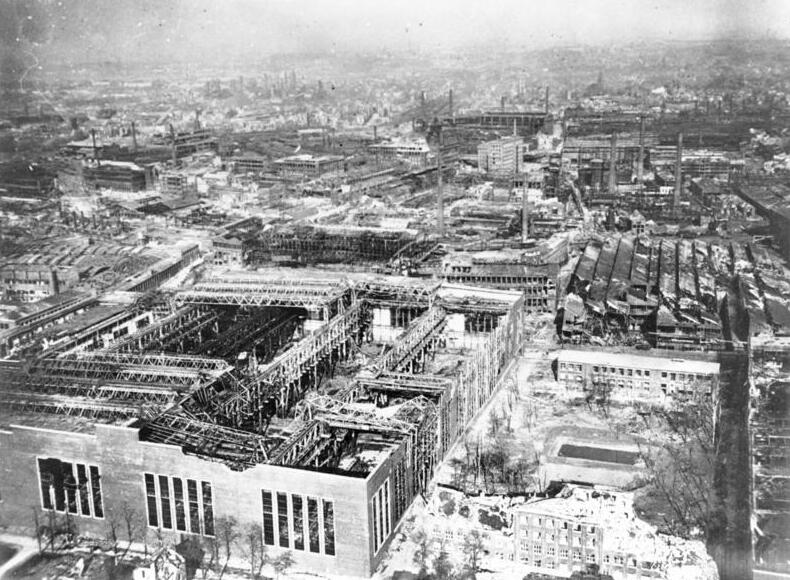
Battle of the Ruhr
The Battle of the Ruhr (5 March – 31 July 1943) was a strategic bombing campaign against the Ruhr Area in Nazi Germany carried out by RAF Bomber Command during the Second World War. The Ruhr was the main centre of German heavy industry with coke plants, steelworks, armaments factories and ten synthetic oil plants. The British attacked 26 targets identified in the Combined Bomber Offensive.[2] Targets included the Krupp armament works (Essen), the Nordstern synthetic oil plant at Gelsenkirchen and the Rheinmetall–Borsig plant in Düsseldorf, which was evacuated during the battle. The battle included cities such as Cologne not in the Ruhr proper but which were in the larger Rhine-Ruhr region and considered part of the Ruhr industrial complex.[3][4] Some targets were not sites of heavy industry but part of the production and movement of materiel.
This article is about the March–July 1943 campaign. For Ruhr Area bombing at other times, see Ruhr Area § History.The Ruhr had been attacked by Bomber Command from 1940; its defences and the amounts of industrial pollutants produced a semi-permanent smog that hampered bomb aiming. Along with anti-aircraft guns, searchlights and night fighters, the Germans built large decoys such as the Krupp decoy site (Kruppsche Nachtscheinanlage) near Essen to spoof the bombers into hitting open country. Cities outside the Ruhr were attacked to prevent the Germans from concentrating their defences and before the end of the battle, Operation Gomorrah on 24 July 1943, began the Battle of Hamburg. After the turn to Hamburg, Bomber Command continued to raid the Ruhr to keep the German defences dispersed.
Aftermath[edit]
Analysis[edit]
In 1956 the New Zealand official historian, Henry Thompson, wrote that at Essen, after more than 3,000 sorties and the loss of 138 aircraft, the "Krupp works...and the town...itself contained large areas of devastation" and Krupp did not resume locomotive production after the second March raid. The battle demonstrated the increasing power of Bomber Command. Targets that hitherto been invulnerable were severely damaged and this appeared to be feasible on targets inside Oboe range. Earlier successes had depended on the weather and occasional opportunities that could not be replicated. Harris saw the Battle of the Ruhr as a beginning and that more cities in Germany would have to be devastated and that the Ruhr would have to be attacked again to keep repaired factories out of production.[61]
In 1981 Matthew Cooper wrote that the most significant event in 1943 for the Luftwaffe was the increase in strategic bombing, the RAF and USAAF dropping 206,188 long tons (209,497 t) of bombs, more than 300 per cent of the 1942 total. Bomber Command dropped 131,000 long tons (133,000 t) of bombs in area attacks and killed about 181,000 civilians. Essen in the Ruhr was attacked on 5/6 March with 1,014 long tons (1,030 t) of bombs, the first of the 43 attacks of the Battle of the Ruhr. The British dispatched 18,506 sorties against targets marked by Oboe, accurate to 200 yd (180 m), dropping about 34,000 long tons (35,000 t) of bombs.[62] In one raid, in fifteen minutes, 90 per cent of Wuppertal-Barmen was destroyed and 2,450 people killed. On 10 April, after visiting Essen to see for himself, Josef Goebbels, the Propaganda Minister, wrote in his diary,